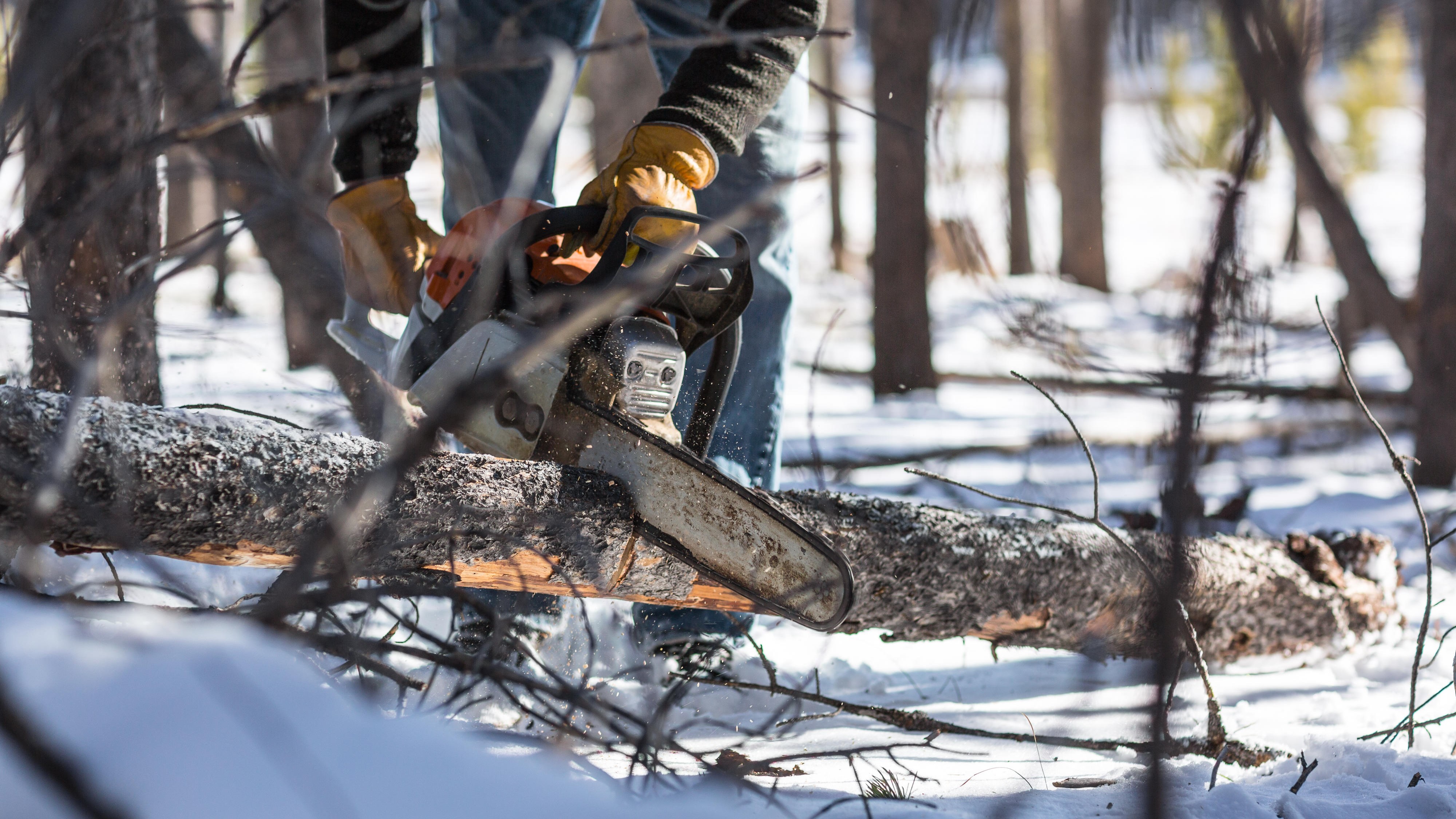
When winter rolls around, many homeowners store their yard tools away until spring arrives. However, there are a few yard tools that may be necessary to use in the winter – a chainsaw being one of them.
You may need one of the best chainsaws to cut logs for the fireplace to keep you warm and cozy. Or perhaps an ice or snowstorm hits and knocks a tree over in your yard. It may be pertinent to cut the tree into pieces right away to protect your home from damage.
Whatever the reason may be, you might need a chainsaw on hand. So – can you use a chainsaw in the winter? And if so, how do you use it safely and without damaging it? We have the answers below, with help from Ben McDermott, senior product manager of professional chainsaws and cutting equipment at Husqvarna.
How to use a chainsaw in winter
1. Check the temperature
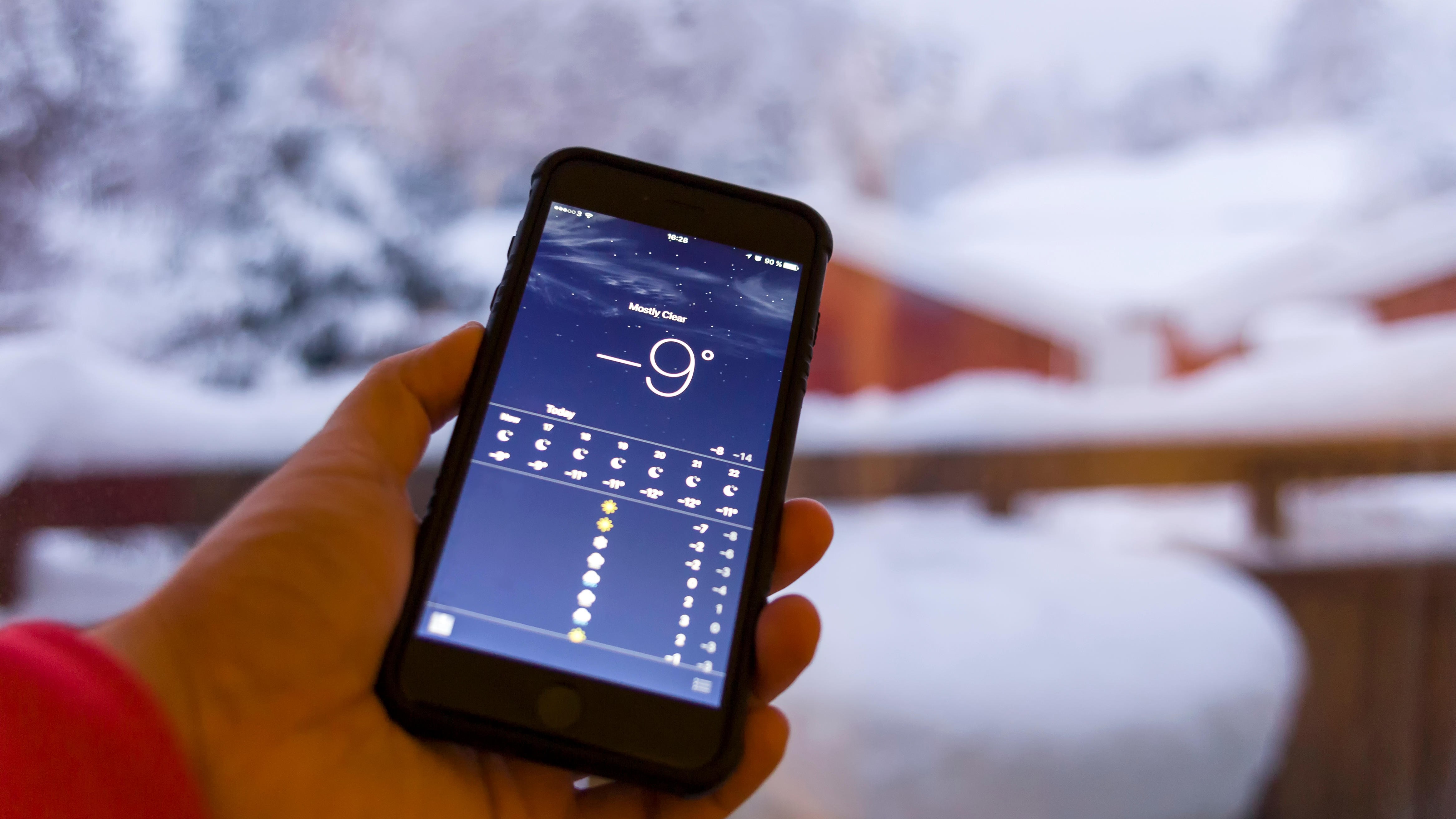
If you’re using a battery-powered chainsaw, you’ll need to first check the temperature to see if it’s too cold to operate the chainsaw.
According to Ben McDermott, Sr. Product Manager of Professional Chainsaws and Cutting Equipment at the Husqvarna Group, “Operating in extreme cold (or hot) conditions can impact the runtime of the battery. Husqvarna recommends operating battery powered chainsaws (like the Husqvarna Power Axe 350i) in ambient working temps between 14 and 104F.”
McDermott adds that users should reference their operator’s manual to see what temperatures are too cold (or too hot) to use a battery-powered chainsaw.
This step does not pertain to gas-powered chainsaws.
2. Gear up – winter style
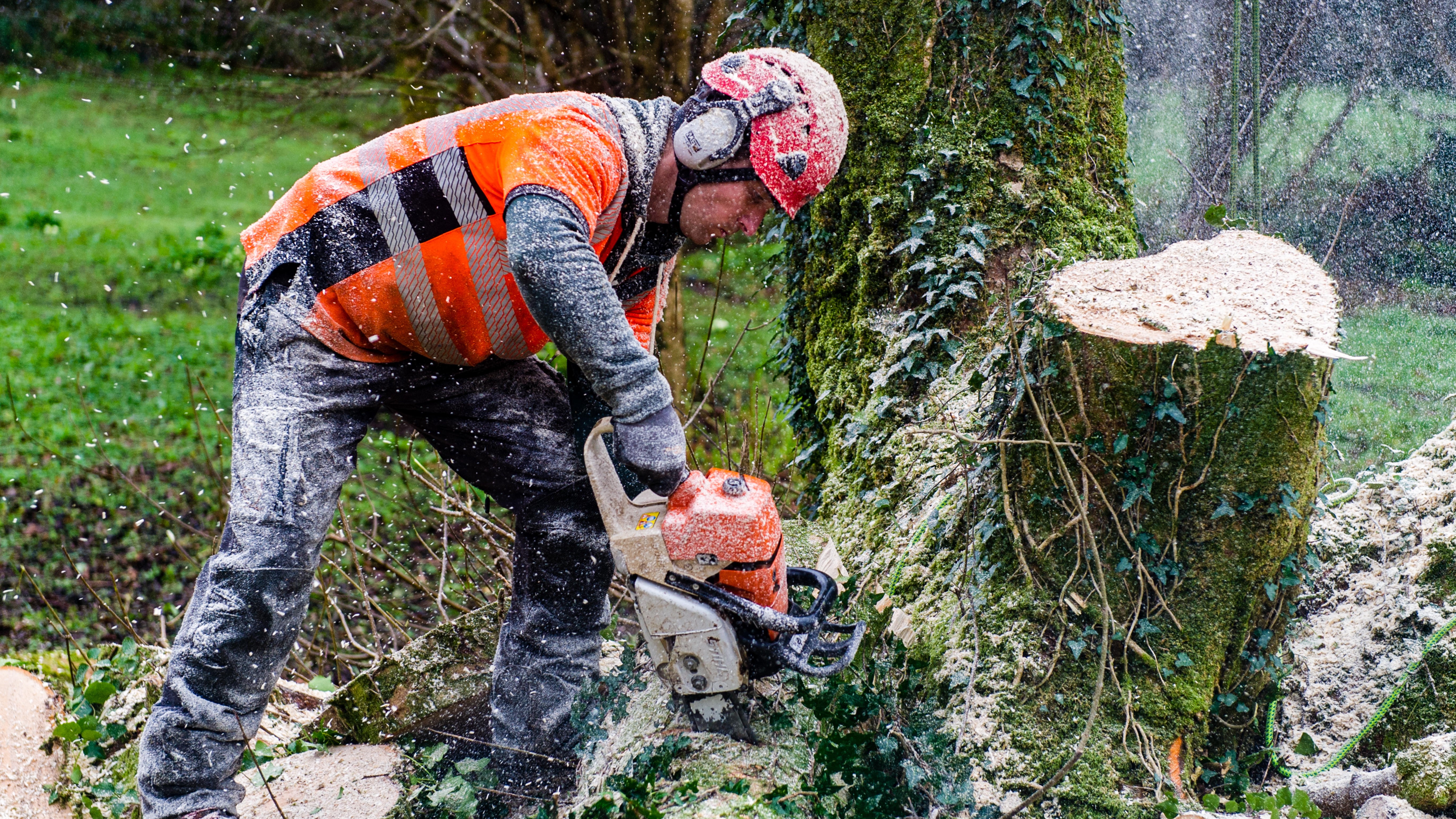
When you use a chainsaw in the winter, you need to “wear proper PPE for chainsaw use (certified pants/chaps, helmet with hearing protection, safety glasses, proper gloves and footwear),” says McDermott. This kit from Amazon ticks a few off the list.
Outfit yourself in warm clothes but make sure they don’t inhibit your ability to handle a chainsaw or allow you to move out of the way of a felling tree. A helmet can protect your head from falling ice and non-slip footwear can keep you secure, standing, and firm on slippery and frozen ground.
Keeping your hands warm is vital when using a chainsaw in the winter. Numb fingers can prevent you from gripping the chainsaw well. Find gloves that resist icing. If you live in a particularly cold area, it might be best to upgrade to a more winter-friendly chainsaw.
3. Sharpen your chain, if need be
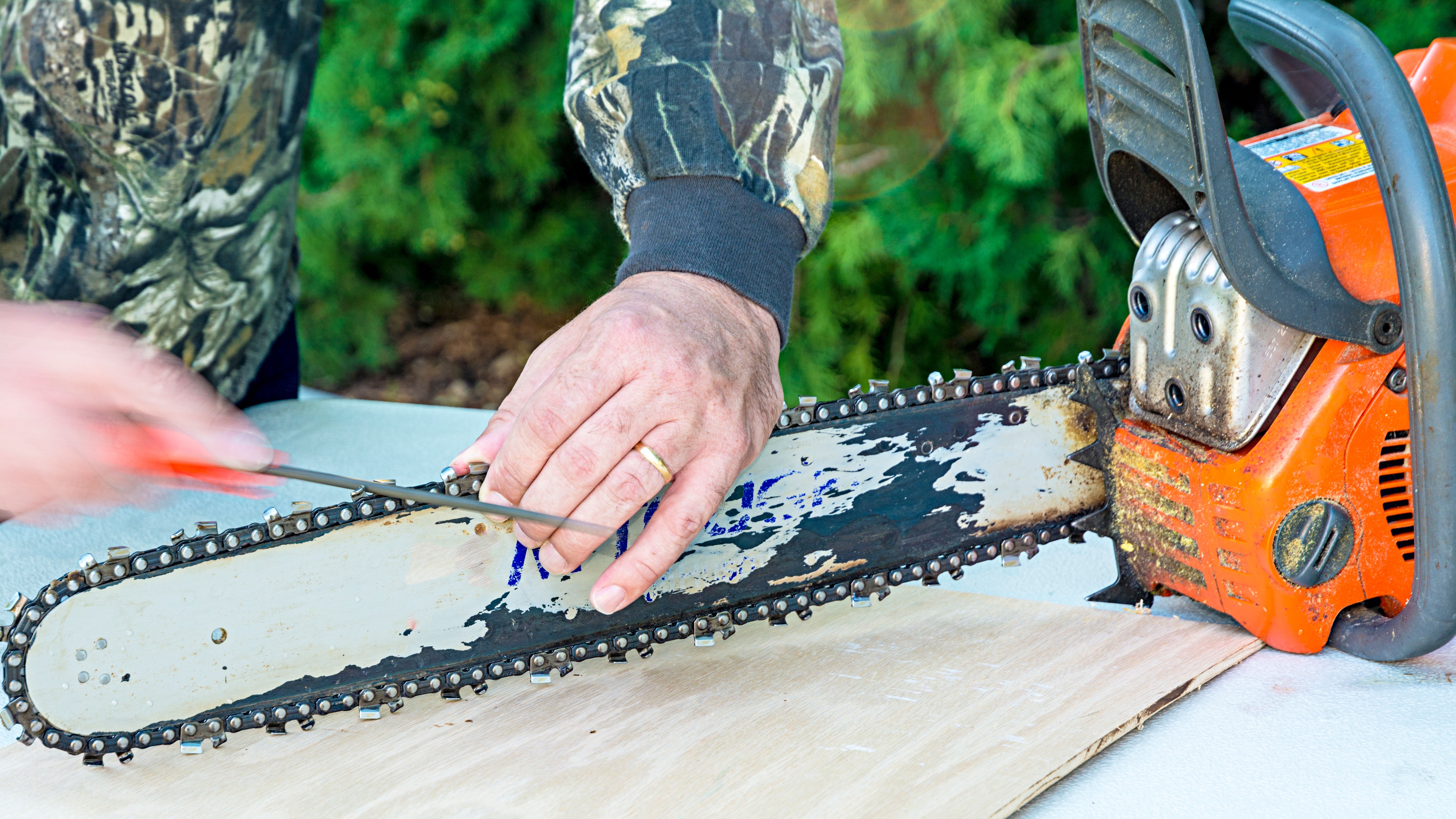
A dull chain isn’t great for any season, but it’s especially a drawback for the winter. For instance, a dull chain could slip against frozen wood and send you to the emergency room with an injury.
“Ensuring you have a sharp chain is always important, but in the winter, frozen and harder woods tend to dull a chain more quickly,” says McDermott. “Keep an extra chain on hand (see options at Amazon) and be prepared to file, if needed.”
If necessary, sharpen your chain before you begin your cutting project. Keep your tools on hand as you may need to sharpen the chain again halfway through.
Also, make sure you know how often to sharpen your chainsaw to keep it cutting at its best.
4. Fill up on winter bar chain oil
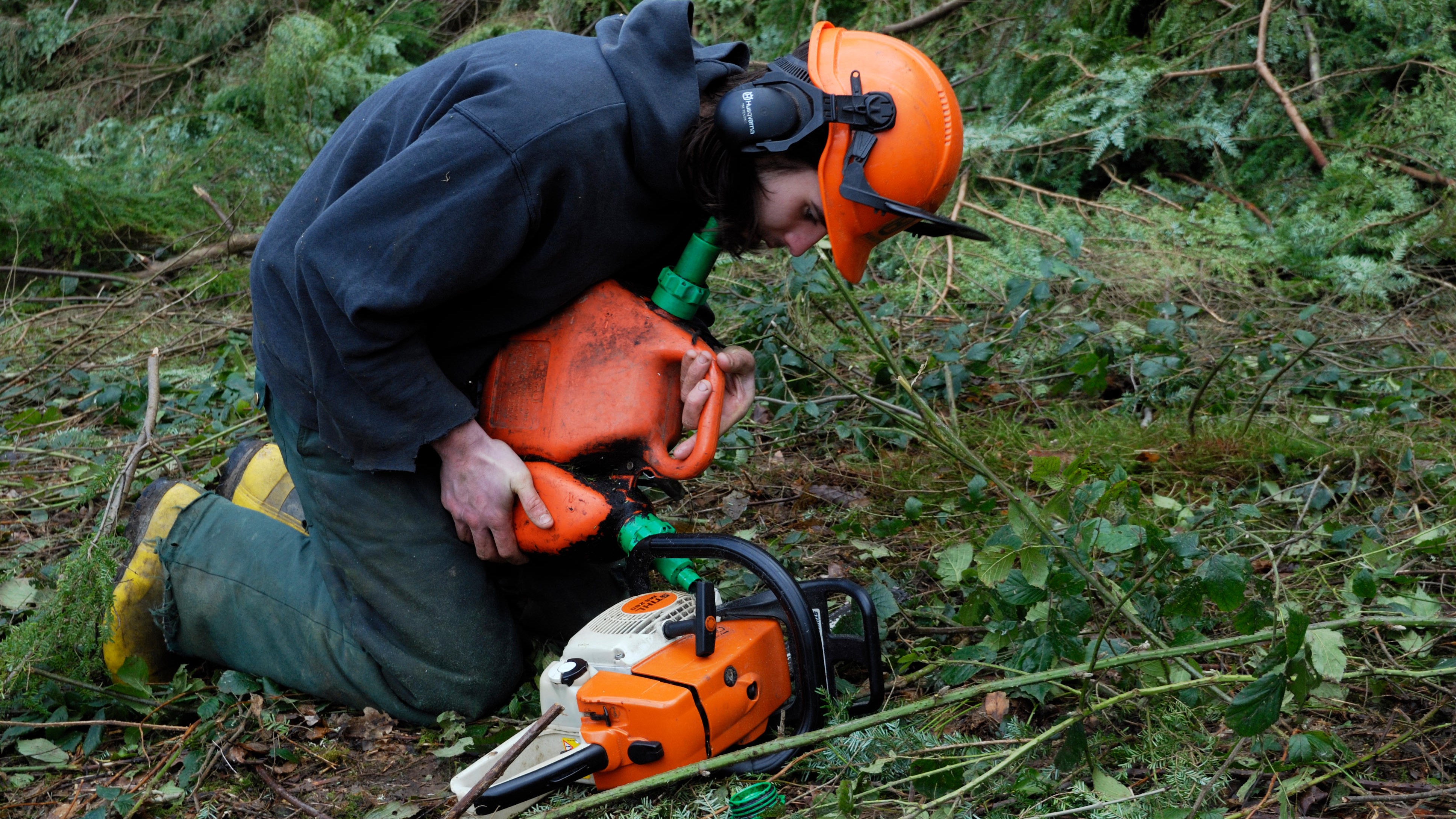
Bar chain oil is designed to reduce heat and friction, protect from rust and corrosion, and prolong the life of the chain and the bar by reducing wear. Most bar chain oils are considered “all-season,” but that’s a bit of a misnomer. Yes, you could use that bar chain oil throughout the entire year, as long as temperatures in your area don’t go below 32-40 degrees Fahrenheit.
During the winter, fill up the oil chamber with bar chain oil designed specifically for colder temperatures, as it is thinner and will be able to flow better.
Husqvarna, DeWalt and EGO Power+ are some of many brands with winter bar chain oil, and some are designed to be used when temperatures are between -20 to 40 degrees Fahrenheit. Browse available options at Amazon to see which would be best for your chainsaw.
5. Check winter settings and use winter accessories (if need be)
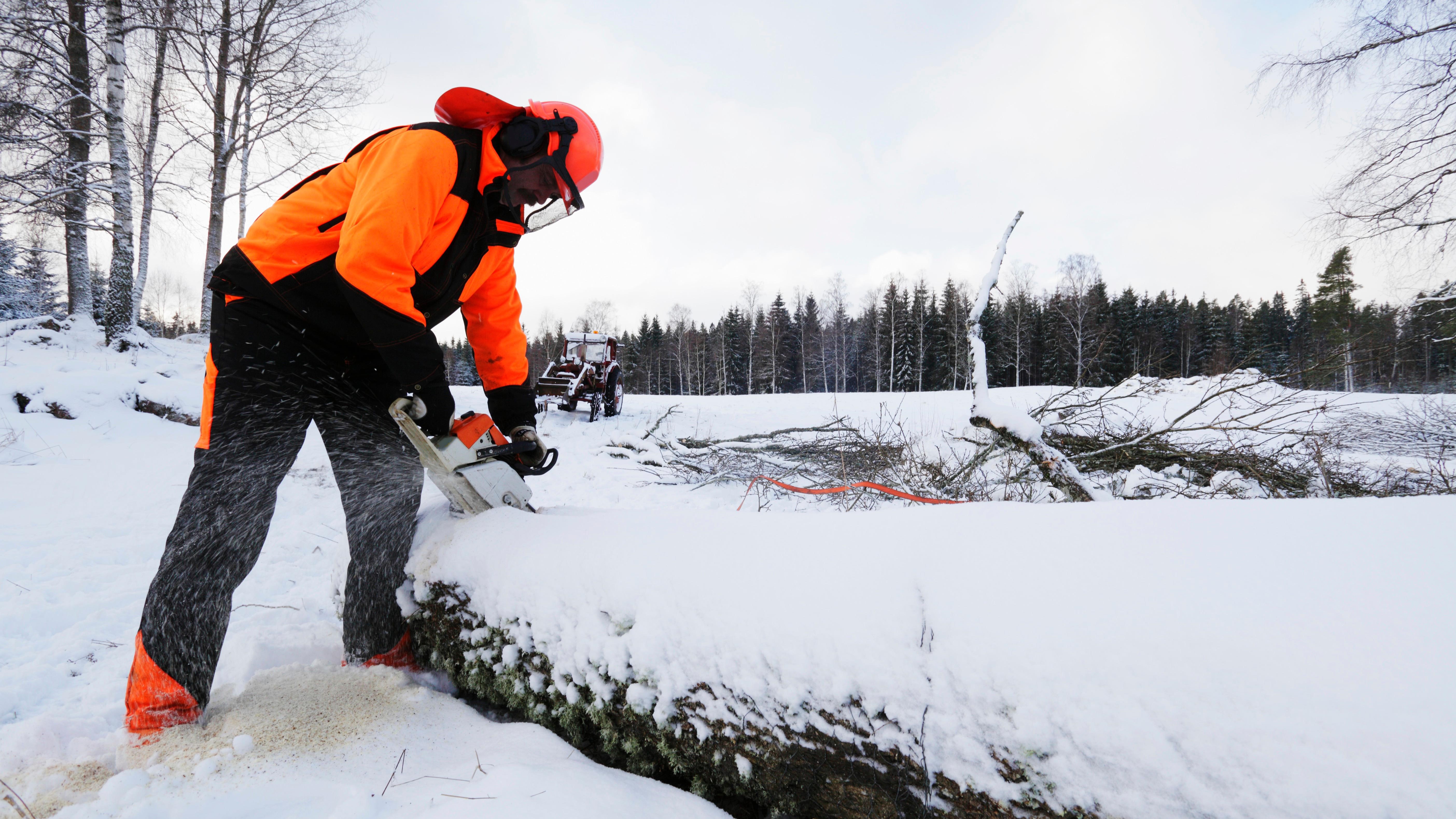
Some gas-powered chainsaws have a winter/summer shutter. It’s imperative that when the temperature gets below 40 degrees, that you move the shutter to the “winter” setting to activate the carburetor preheater system which would prevent the carburetor from icing.
If it’s especially chilly outside, you might want to fit your chainsaw with special accessories to protect it from harsh wintry conditions like cold air, ice, and snow. This Husqvarna winter kit at Amazon is a great start.
"Winter guards prevent snow and cold air from entering the intake and a special air filter designed for colder/wet conditions which help prevent the filter from freezing,” McDermott explains.
6. Remove snow and ice and cut with care
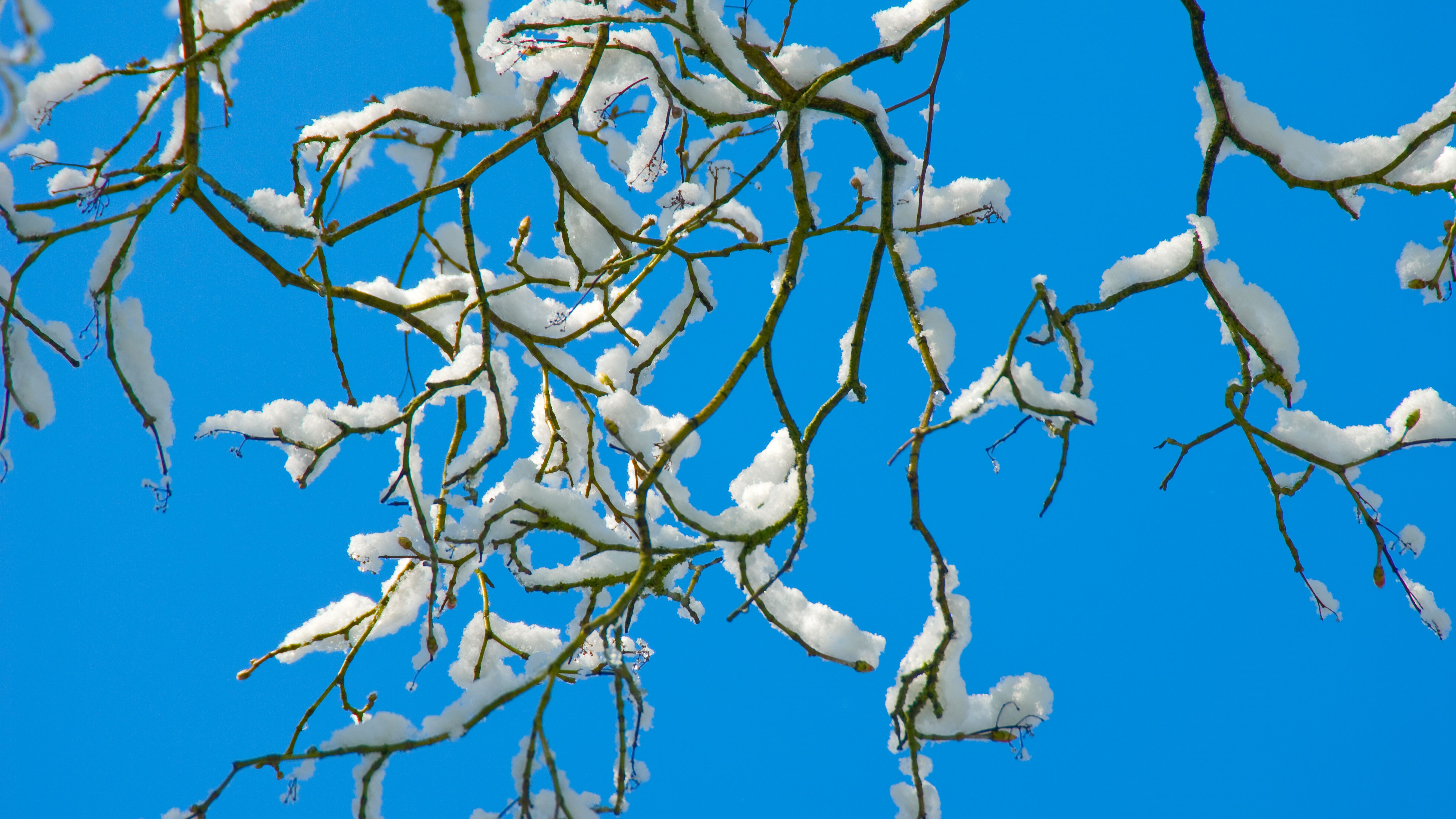
Before you begin cutting, remove as much snow and ice from the trunk and limbs. For one, if snow falls off while you’re cutting, it could be a distraction or obscure your vision, resulting in a safety concern. Also, when a tree is covered in snow, especially the crown, it affects the tree’s center of gravity which will affect how you will need to cut the tree so that it can be felled in the right direction.
Take note that cold temperatures can transform even the softest types of trees into hard and brittle wood, making it more difficult to cut through. So don’t necessarily expect your chainsaw to cut as quickly or as easily as it does in the summer.
Not to mention, “cutting wood in freezing temperatures can pose additional risks as the wood is less flexible and more likely to crack or splinter,” says McDermott, which is why safety glasses are a must-wear in the winter.
7. Keep snow, ice, and moisture off the chainsaw as you operate
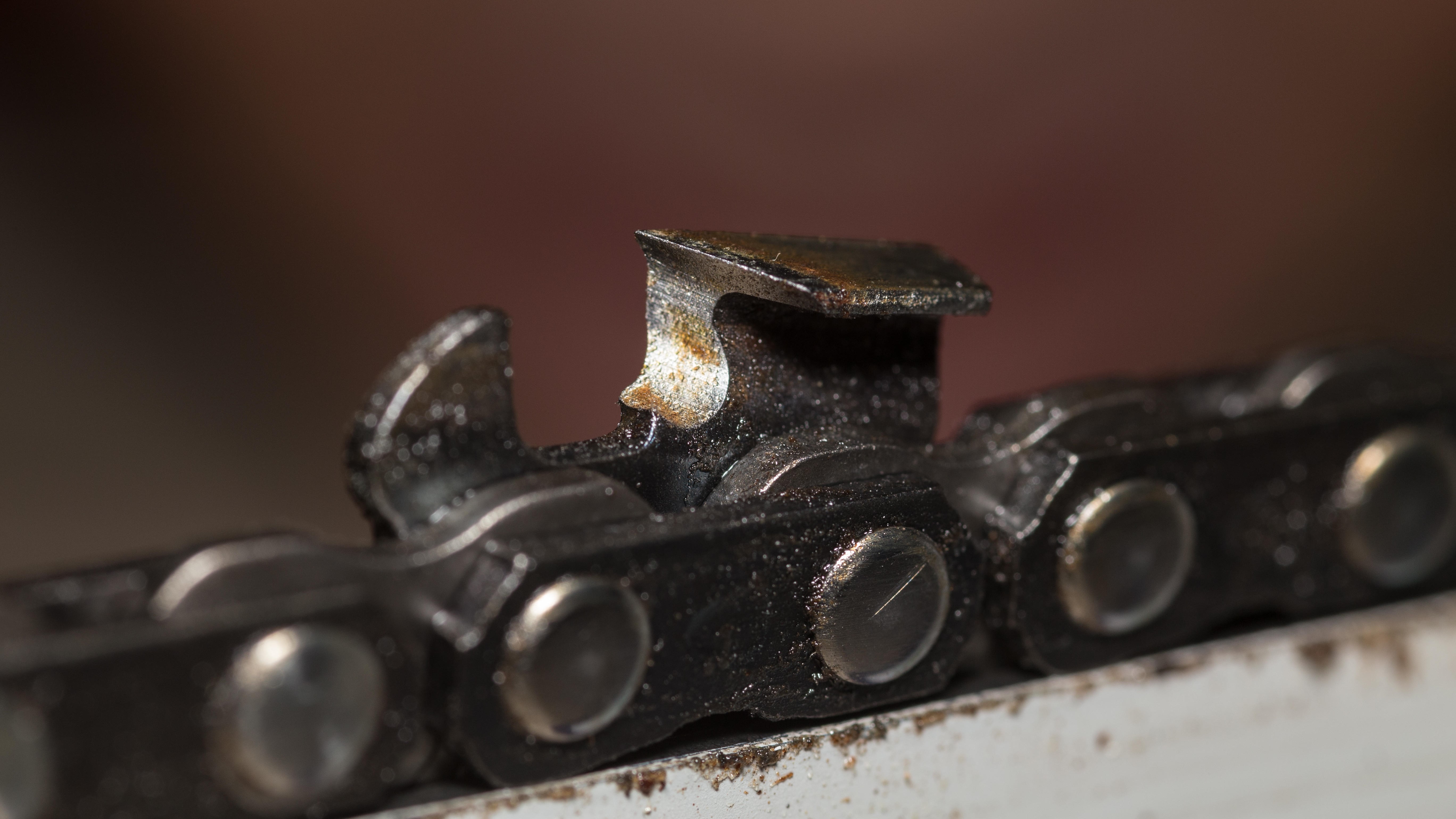
The cold is not too kind to gas- or battery-powered chainsaws. Too much cool moisture in a gas-powered chainsaw engine can make it difficult to start the chainsaw or prevent it from working completely. Even melted snow on the bar and chains can affect the oil’s ability to lubricate the chain for proper cutting.
Use a brush to clean snow and sawdust away from the bar, chain, gas filler caps, sprocket cover, chain brake, anti-vibration system, throttle and trigger, and cooling air intake as you work. If you notice that the chainsaw is icing up, remove the ice immediately.
8. Clean up and store properly
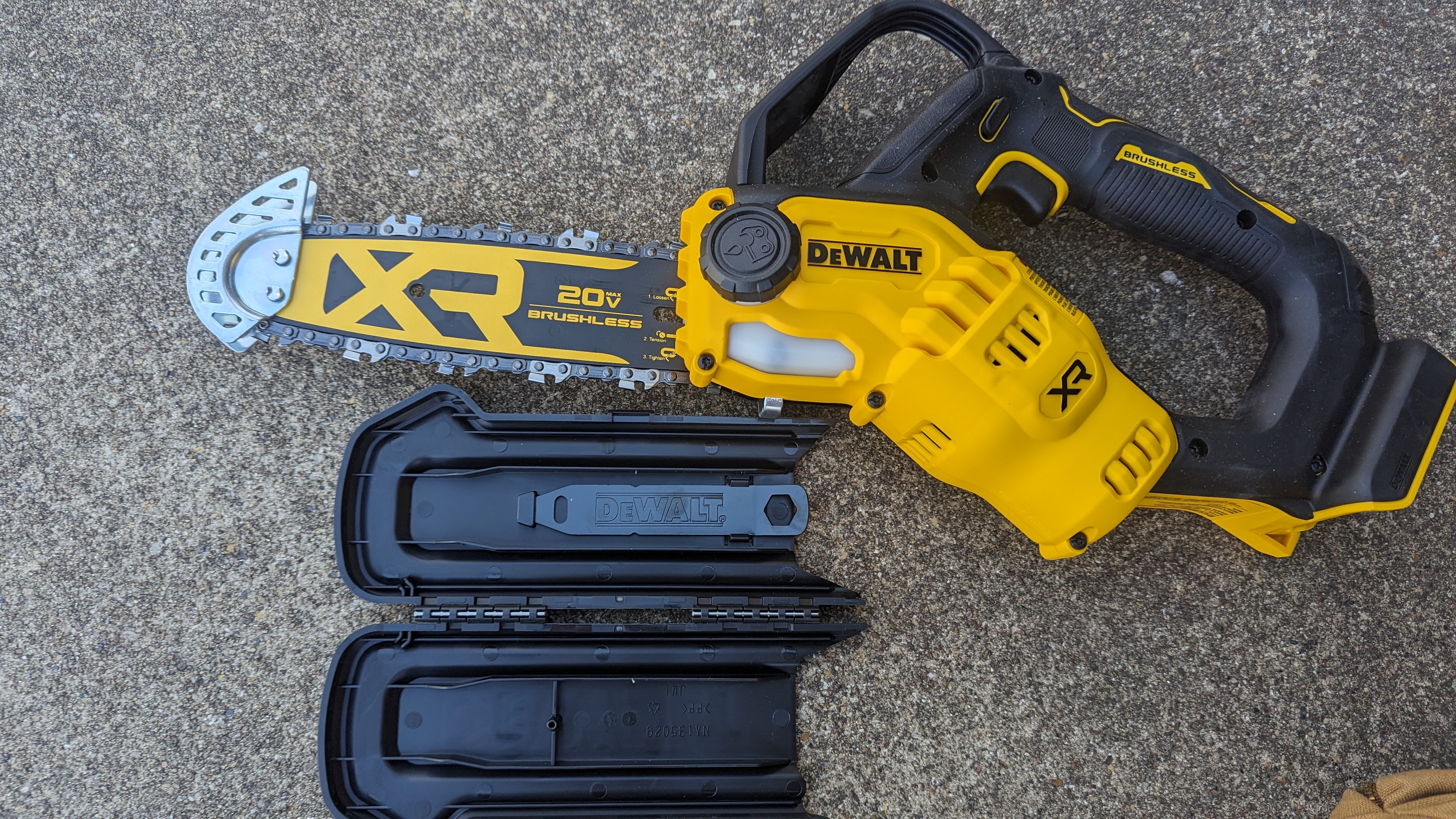
When you’re done with the chainsaw, give the machine a full cleaning with a brush. You may want to remove the chain so that you can get all the bits of sawdust, ice, and snow off the bar.
When the weather is below 15 degrees, the chain can contract or tighten on the bar which could stretch the rivets until the chain is ruined. Loosen the chain when you’re done using the chainsaw to prevent this from happening.
If you’re using a battery-powered chainsaw, remove the batteries and re-charge them. McDermott notes that, “Storing and charging batteries in ideal temperatures ensures optimal runtime and battery lifetime. Recommended temps may differ by manufacturer, but Husqvarna recommends storing batteries between 41-77 degrees F and an ambient charging temp between 41 and 114 F.”
With this in mind, it’s best to store batteries indoors and not in a garage or shed, unless it’s insulated and/or heated to ambient temperatures.
Gas-powered chainsaws should especially be kept in a dry and warm area as they are easily affected by cool, moist air. You may want to invest in a chainsaw cover that’s made of plastic or material for some additional protection.
FAQs
What if I want to store the chainsaw away for the winter?
If you want to winterize your gas-powered chainsaw, or store it away for the winter, there are a few things you need to do, according to McDermott.
“It’s important to make sure the fuel and bar & chain oil tanks are empty. If storing a gas-powered chainsaw, I would also recommend running the saw using an ethanol free fuel mix (Husqvarna XP+ premixed fuel) just before storing,” he says.
“This will ensure no fuel containing ethanol is trapped in the system while in storage and prevent possible corrosion of fuel lines and engine components.”
From there, clean and/or replace the air filter before cleaning off the coil fins with a brush and any grime on the chainsaw with a rag. Remove the bar and chain so that you can clean the sprocket. Before you put the chain back on, you could use a biodegradable corrosion inhibitor on the bar and chain to prevent rusting over the winter.
McDermott also recommends daily, weekly, and monthly maintenance that’s laid out in the chainsaw’s operator’s manual. “Check the guide bar, sharpen the chain, conduct a check of the safety features, remove covers and gently clean any sawdust or debris collected over the cutting season. Also, check the filters and spark plugs,” he explains.
Just as with a gas-powered chainsaw, if you want to store the battery-powered chainsaw for the entire winter season, you’ll need to empty the chain oil, clean the bar, and run maintenance checks. Don’t forget to store your battery and battery charger somewhere that doesn’t get below 41 degrees.
Are there any other things I need to do for my chainsaw in the winter?
Starting a chainsaw once a week and running it for a few minutes could make it easier for the chainsaw to start when you actually need it.
It might not be a bad idea to have a bottle of HEET Gas-Line Antifreeze and Water Remover (Amazon) on hand as it can remove moisture and prevents freezing and rust in the gas line of your chainsaw.
Final thoughts
While it may take a few more steps and considerations to use a chainsaw in the winter, you'll be glad that you do. Winter brings with it extreme temperatures and conditions and when working with a gardening tool like a chainsaw, it's always best to be safer than sorry.
Following our advice above will ensure that your chainsaw will be in solid shape to use once again when spring and summer rolls around.







